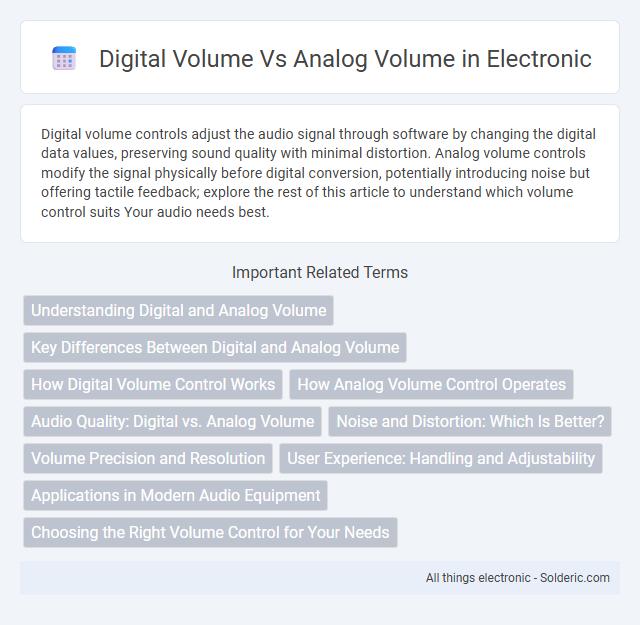Digital volume controls adjust the audio signal through software by changing the digital data values, preserving sound quality with minimal distortion. Analog volume controls modify the signal physically before digital conversion, potentially introducing noise but offering tactile feedback; explore the rest of this article to understand which volume control suits Your audio needs best.
Comparison Table
| Feature | Digital Volume | Analog Volume |
|---|---|---|
| Control Method | Adjusts volume using digital signal processing (DSP) | Adjusts volume by varying the analog signal amplitude |
| Signal Quality | May introduce quantization noise at low volume levels | Provides natural, continuous signal attenuation |
| Precision | High precision with discrete steps | Variable precision depending on hardware |
| Complexity | Requires digital circuitry and software algorithms | Simple circuitry with potentiometers or analog components |
| Power Consumption | Typically higher due to DSP processing | Lower power, mainly passive components |
| Integration | Easier to integrate with digital devices and systems | Better suited for traditional analog audio setups |
| Dynamic Range | Limited by bit-depth of digital processing | Generally wider dynamic range |
| Cost | Potentially higher due to digital components | Generally lower cost |
Understanding Digital and Analog Volume
Digital volume controls adjust audio levels by modifying the digital signal's amplitude before conversion to analog, preserving signal integrity and enabling precise volume steps without noise introduction. Analog volume controls regulate output by attenuating the analog signal after digital-to-analog conversion, which may introduce distortion or noise at low levels. Understanding these differences helps you choose the best volume control method for maintaining audio fidelity in your equipment.
Key Differences Between Digital and Analog Volume
Digital volume control adjusts audio levels using precise numerical values, ensuring consistent sound quality without introducing noise or distortion. Analog volume control varies voltage in a continuous signal path, which can lead to subtle changes in audio warmth but may introduce noise or signal degradation. Understanding the key differences helps you choose the ideal volume control for your audio setup, balancing fidelity and tactile control.
How Digital Volume Control Works
Digital volume control adjusts sound levels by modifying audio signal amplitude using binary values in a digital audio processor, providing precise and noise-free volume adjustments without affecting signal quality. Unlike analog volume control that varies voltage through physical components, digital volume uses algorithms to scale the digital audio data before conversion to analog signals. This method enables consistent audio performance across devices and integration with digital signal processing features.
How Analog Volume Control Operates
Analog volume control operates by adjusting the amplitude of the audio signal through variable resistors or potentiometers, directly modifying the analog waveform before conversion or amplification. This allows for a continuous and smooth change in volume levels without altering the signal's digital integrity, preserving the original audio quality as it reaches your speakers or headphones. The direct manipulation in the analog domain results in a more natural sound experience, favored in high-fidelity audio systems.
Audio Quality: Digital vs. Analog Volume
Digital volume control maintains audio quality by adjusting the signal level without introducing noise or distortion, ensuring clean sound even at lower volumes. Analog volume control can degrade audio fidelity due to signal attenuation and potential interference, often causing noise or loss of detail. Your listening experience benefits from digital volume settings by preserving clarity and dynamic range throughout the volume adjustment.
Noise and Distortion: Which Is Better?
Digital volume control excels in minimizing noise and distortion by adjusting audio levels through digital signal processing, preserving sound clarity even at lower volumes. Analog volume control can introduce noise and distortion due to physical components like potentiometers, especially at reduced levels. For your audio system, digital volume adjustment generally offers cleaner sound quality with less interference compared to analog controls.
Volume Precision and Resolution
Digital volume control offers high precision and resolution by adjusting audio levels through discrete digital steps, minimizing signal degradation and maintaining consistent sound quality across volume changes. Analog volume control relies on variable resistors or potentiometers, which can introduce noise, distortion, and less precise adjustments due to component tolerances and mechanical wear. The resolution of digital volume is typically defined by bit depth (e.g., 16-bit or 24-bit), enabling finer increments compared to the continuous but less accurate analog methods.
User Experience: Handling and Adjustability
Digital volume controls offer precise and consistent adjustments, providing users with a more refined listening experience and eliminating issues like channel imbalance common in analog systems. Analog volume controls allow for smooth, continuous changes that some users find more intuitive and natural, but they may suffer from signal degradation or noise at lower settings. Your choice between digital and analog volume adjustment impacts ease of use, sound quality, and overall satisfaction with audio handling.
Applications in Modern Audio Equipment
Digital volume control allows precise adjustments without degrading audio quality, making it ideal for modern audio equipment such as headphones, smartphones, and smart speakers. Analog volume control is often favored in high-end audiophile gear due to its smooth, continuous control and minimal latency. Hybrid systems combining digital precision and analog warmth are increasingly common in advanced audio devices to optimize sound performance and user experience.
Choosing the Right Volume Control for Your Needs
Digital volume control offers precise adjustment and maintains audio quality by avoiding analog signal degradation, ideal for your modern digital audio systems. Analog volume control provides a warmer, classic sound preferred by audiophiles and works well with traditional audio equipment. Selecting the right volume control depends on your audio environment, the equipment you use, and whether sound fidelity or nostalgic warmth is your priority.
Digital volume vs Analog volume Infographic

 solderic.com
solderic.com